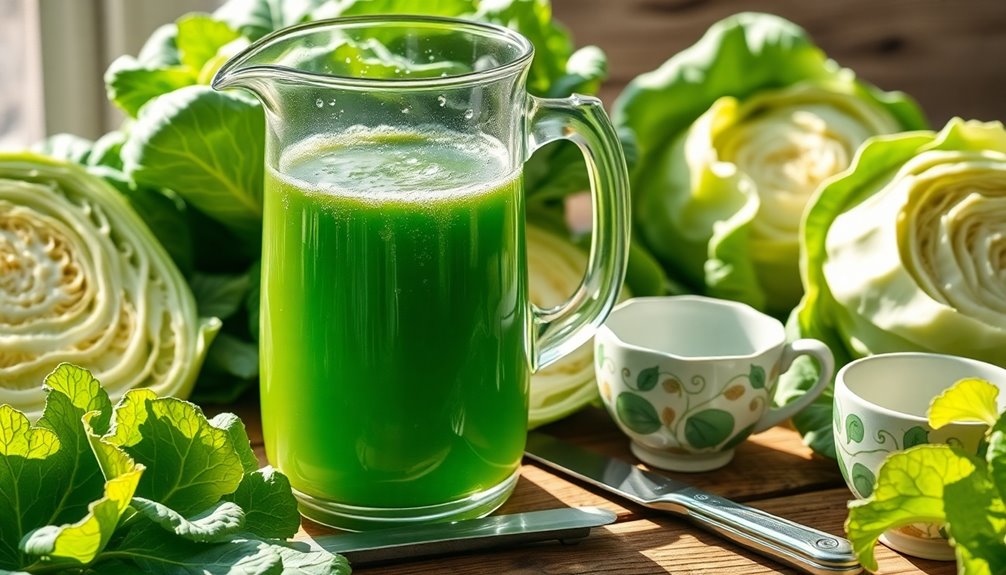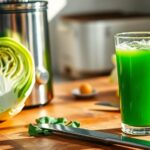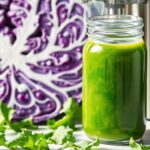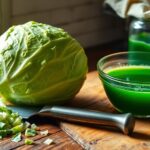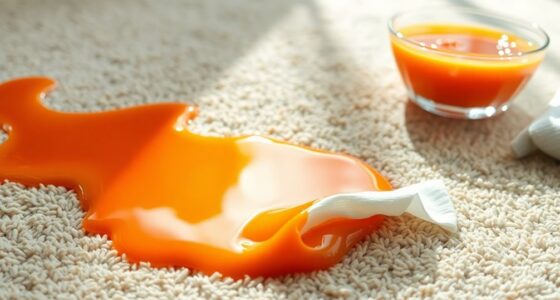Making cabbage juice is simple! Start by washing and chopping fresh cabbage into 1-inch pieces. For extra flavor, you can add ginger, apples, or cucumbers. Blend the chopped cabbage with a little filtered water until smooth, then strain the mixture using a nut milk bag or mesh sieve to separate the juice from the fiber. Serve it fresh for the best taste, and consider adding lemon juice for a zesty kick. There’s so much more to explore about this nutritious drink! To enhance your cabbage juice, you can experiment with different spices or herbs, such as mint or turmeric, which can add unique flavors and additional health benefits. If you’re curious about how to prepare cabbage juice, remember that it’s not just a refreshing beverage; it can also be incorporated into smoothies or salad dressings for an extra nutrient boost. Plus, storing any leftover juice in the refrigerator allows you to enjoy this vibrant drink throughout the week!
Key Takeaways
- Wash and chop fresh green cabbage into 1-inch pieces; consider adding ginger, apples, or cucumbers for extra flavor and hydration.
- Blend the chopped cabbage and additional ingredients with a small amount of filtered water until smooth, following your blender or juicer instructions.
- Strain the blended mixture through a nut milk bag or mesh sieve to separate the juice from the fiber for a smoother drink.
- Serve the cabbage juice immediately for maximum health benefits, or store it in an airtight container in the fridge for up to 3-4 days.
- Enhance the flavor with a splash of lemon juice and experiment with various fruits and vegetables for different combinations.

Cabbage juice is a nutritious and refreshing drink that's easy to make at home. If you're looking to incorporate more vitamins and minerals into your diet, this vibrant green beverage is a fantastic choice. You can create your own cabbage juice recipes by using fresh ingredients and your favorite flavors. Start with firm green cabbage, which is loaded with health benefits, including antioxidants and vitamins C and K.
To get started, wash your fresh green cabbage thoroughly. Once it's clean, chop it into 1-inch pieces. You can also add other ingredients to elevate the flavor and nutrition of your juice. Consider including fresh ginger for a spicy kick or even some apples or cucumbers for sweetness and hydration.
When you've prepared your ingredients, it's time to begin the juicing process. If you're using a blender, this is where the fun begins. Add the chopped cabbage and any additional ingredients to the blender. Pour in a small amount of filtered water to help everything blend smoothly. This is crucial because it ensures you achieve that perfect juice consistency. Blend the mixture for about 1-2 minutes until it's nice and smooth.
If you prefer a juicer, just follow the manufacturer's instructions to extract the juice efficiently. Once you have a smooth mixture, the next step is to pour the mixture through a nut milk bag or a mesh sieve. This process separates the juice from the fiber, giving you that refreshing drink you desire. Don't rush through this step; taking the time to strain properly ensures a smoother final product that's more enjoyable to drink.
Now that you've got your fresh cabbage juice ready, it's best to serve it immediately. Serving the fresh cabbage juice right away maximizes its health benefits, so don't wait too long to enjoy it. If you need to store it, pour it into an airtight container and keep it in the fridge for up to 3-4 days. However, for the best experience, fresh is always the way to go.
To enhance the flavor even further, consider adding a splash of lemon juice. The citrusy zing pairs wonderfully with the earthy notes of cabbage, while fresh ginger adds a delightful warmth. Feel free to experiment with different combinations of fruits and vegetables; the possibilities are endless when it comes to your cabbage juice recipes.
Frequently Asked Questions
How to Make Juice From Cabbage?
To make juice from cabbage, start by washing and chopping fresh cabbage into 1-inch pieces.
If you're using a blender, blend the chopped cabbage with a bit of filtered water until smooth, then strain it to get the juice.
If you've got a juicer, just feed the cabbage through it.
You can add flavors like lemon juice or ginger for a tasty twist.
Enjoy your fresh juice right away or store it in the fridge!
Can I Boil Cabbage and Drink the Juice?
Bubbling broth beckons! Yes, you can boil cabbage and drink the juice. When you chop the cabbage and simmer it for about 30 minutes, you create a soothing liquid that may aid digestion.
While it offers some health benefits, remember it won't pack the same punch as fresh juice. For the best taste and nutrition, sip it soon after cooking, as storing can sap its strength.
Enjoy your gentle, green goodness!
How to Make Cabbage Juice Without a Juicer?
To make cabbage juice without a juicer, start by washing and chopping your cabbage into small pieces.
Add those pieces to a blender along with a bit of filtered water. Blend for 1-2 minutes until it's smooth.
Then, strain the mixture through a nut milk bag or fine mesh sieve to separate the juice from the pulp. Once you have strained the mixture, you can use the leftover pulp in various recipes, such as smoothies or baked goods, to avoid wastage. This process allows you to enjoy a refreshing drink while ensuring that nothing goes to waste. With just a few simple ingredients and tools, you can easily make fresh concentrate juice at home that rivals store-bought options.
Enjoy your fresh juice immediately or store it in the fridge for up to three days!
How Much Cabbage Juice Should I Drink a Day?
Think of cabbage juice as a green elixir for your health. You should drink 8 oz. of it 1 to 4 times daily for the best ulcer healing benefits.
Start with ½ cup to ease your digestive system into it, then gradually increase your intake. Consistency is key, and in about 9 days, you might notice improvements.
Always check with your healthcare provider for tailored advice, especially if you have any digestive issues.
Conclusion
Making cabbage juice is a simple process that can boost your health and add variety to your diet. Remember, "you are what you eat," so incorporating nutrient-rich foods like cabbage can have a positive impact on your well-being. Whether you enjoy it straight or mixed with other juices, this vibrant drink is a great way to benefit from the vitamins and minerals cabbage offers. So, grab your blender and start juicing for a healthier you!
Cindy thoroughly researches juicing trends, techniques, and recipes to provide readers with practical advice and inspiration. Her writing style is accessible, engaging, and designed to make complex concepts easy to understand. Cindy’s dedication to promoting the advantages of juicing shines through her work, empowering readers to make positive changes in their lives through the simple act of juicing.

